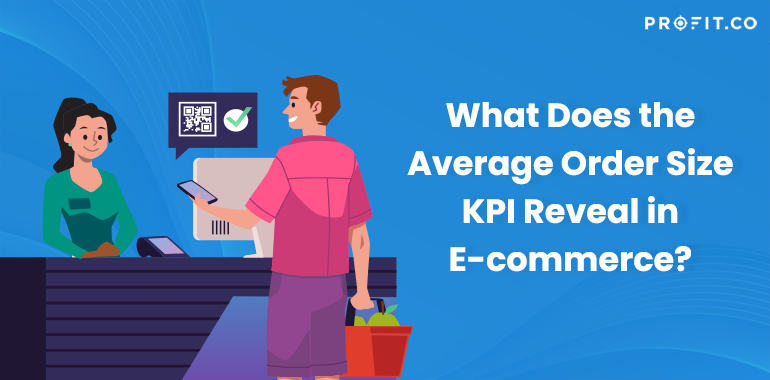“We can’t be in survival mode. We have to be in growth mode.”
What is the Average Order Size (AOS)?
Average Order Size is a vital e-commerce KPI that measures the average amount spent by customers per transaction. It provides a snapshot of purchasing habits and helps businesses understand how much their customers are willing to spend.
The Importance of AOS
AOS is more than just a number; it’s a reflection of customer behavior and a benchmark for evaluating the effectiveness of sales strategies. A higher AOS indicates that customers are spending more per transaction, which can lead to increased overall revenue even if the number of transactions doesn’t grow.
Seeking tailored strategies for your e-commerce business? Here is what you need to know about AOS KPI
Formula to Calculate AOS
The formula for calculating Average Order Size is straightforward:

By dividing the total revenue within a specific period by the number of orders in that same period, you obtain the average value of each transaction.
Real-Life Example
Consider an online bookstore. Over one month, they generated $50,000 in revenue from 1,000 orders. Using the AOS formula:
Average Order Size = $50,000/$1000= $50
This means the average customer spends $50 per order. If the bookstore implements strategies like bundling popular books or offering a discount on orders over $60, they could potentially increase their AOS. Suppose these strategies lead to a new AOS of $55. This increase, though seemingly small, can significantly impact overall revenue.
Strategies to Improve AOS
Improving the Average Order Size (AOS) is a strategic goal for many e-commerce businesses, as it directly impacts revenue and profitability. Here are some effective strategies to increase AOS
Cross-Selling and Upselling
Suggest related products or higher-end alternatives to customers. For instance, recommend accessories for electronics or premium versions of products.
Bundling Products
Create bundles or packages of complementary items at a slightly reduced price compared to purchasing them individually. This encourages customers to buy more.
Volume Discounts and Tiered Pricing
Offer discounts for buying in bulk or pricing tiers that encourage purchasing more items to get a better deal.
Loyalty Programs
Implement a rewards program that incentivizes higher spending, like earning points for each dollar spent which can be redeemed for discounts or freebies.
Free Shipping Threshold
Set a minimum purchase amount for free shipping. This encourages customers to add more items to their cart to qualify for the offer.
Showcasing Best Sellers and New Arrivals
Highlight popular and new products that align with customer interests, which can prompt larger purchases.
By implementing these strategies, e-commerce businesses can effectively increase their Average Order Size, enhancing overall sales and revenue. Each strategy should be tailored to fit the unique context and customer base of the business.
Measuring AOS KPI with OKRs
Creating Objectives and Key Results (OKRs) around the “Average Order Size (AOS)” KPI in e-commerce involves setting clear goals with quantifiable outcomes (Key Results). Here’s an example of how these could be structured:
Objective: Maximize the Average Order Size to Enhance Revenue in E-commerce
Key Result 1: Increase AOS from $50 to $75
Initiatives
- Implement upselling strategies at checkout, offering complementary products or upgrades.
- Create and promote product bundles that offer a better value compared to individual purchases.
- Develop and introduce a loyalty program that rewards customers based on the value of their purchases.
Key Result 2: Grow the Percentage of Transactions Over $100 from 10% to 25%
Initiatives
- Launch targeted marketing campaigns for high-value products.
- Offer exclusive discounts or benefits for purchases over $100.
- Analyze customer purchase history to personalize product recommendations that encourage larger purchases.
Key Result 3: Increase the frequency of bulk purchases from 10% to 25%
Initiatives
- Introduce volume discounts or tiered pricing for bulk purchases.
- Partner with suppliers to offer special deals on bulk orders.
- Run a marketing campaign focusing on the benefits and savings of bulk buying.
Final Thoughts
In conclusion, optimizing Average Order Size is a powerful strategy for boosting revenue in e-commerce. By understanding and applying the right techniques to influence this KPI, businesses can enhance their sales efficiency and customer spending. Always remember, in the competitive world of online retail, even small increases in key metrics like AOS can lead to substantial gains in overall business performance.
Have questions about tracking Average Order Size KPI? Our team is here to help
Related Articles
-
ARR Multiple: A Key Metric for SaaS Valuation
In the Software-as-a-Service (SaaS) Industry, understanding how a company is valued is crucial for both founders and investors. One metric... Read more
-
Abandoned Checkouts: Why They Happen and How to Fix Them
In e-commerce, few challenges are as persistent and as costly as abandoned checkouts. Despite a shopper's clear intent to buy,... Read more
-
From Baseline to Target: Mastering the Science of KPI Progress
KPIs (Key Performance Indicators) are more than just numbers on a spreadsheet they're the compass that guides your business toward... Read more
-
Understanding Planned Value and Its Importance in Project Management
In project management, monitoring and measuring progress are essential to ensuring that projects stay on track and deliver expected results.... Read more

